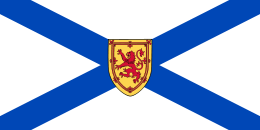Government of Nova Scotia
|
| |
| Formation | 1867 |
|---|---|
| Country | Canada |
| Website | gov.ns.ca |
| Legislative branch | |
| Legislature | House of Assembly |
| Meeting place | Province House |
| Executive branch | |
| Main body | Executive Council |
| Head of Government | Premier |
| Viceregal Representative | Lieutenant Governor |
| Judicial branch | |
| Court | Supreme Court |
| Seat | Halifax |
The Government of Nova Scotia refers to the provincial government of the Canadian province of Nova Scotia. Its powers and structure are set out in the Constitution Act, 1867.
In modern Canadian use, the term "government" refers broadly to the cabinet of the day (formally the Executive Council of Nova Scotia), elected from the Nova Scotia House of Assembly and the non-political staff within each provincial department or agency – that is, the civil service.
The Province of Nova Scotia is governed by a unicameral legislature, the Nova Scotia House of Assembly, which operates in the Westminster system of government. The political party that wins the largest number of seats in the legislature normally forms the government, and the party's leader becomes premier of the province, i.e., the head of the government.
Premier of Nova Scotia
Sworn in as premier on October 22, 2013, Hon. Stephen McNeil became the 28th Premier of the Province of Nova Scotia since Confederation. Premier McNeil was elected Leader of the Nova Scotia Liberal Party in 2007.
Lieutenant Governor of Nova Scotia
The functions of the Sovereign, Elizabeth II, Queen of Canada, and known in Nova Scotia as the Queen in Right of Nova Scotia, are exercised by the Lieutenant Governor of Nova Scotia. The Lieutenant Governor is appointed by the Governor General of Canada on the recommendation of the Prime Minister of Canada, in consultation with the Premier of Nova Scotia.
Finance
The Nova Scotia government ended 2010-2011 with a surplus of $569 million and reduced its debt to $12.8 billion, down $217.8 million. Expenses for the year were $9.3 billion, down $171.5 million, and revenues were $9.9 billion, an increase of $666.1 million.[1]
Ministries
- Department of Agriculture
- Department of Community Services
- Department of Economic and Rural Development and Tourism
- Department of Education and Early Childhood Development
- Department of Energy
- Department of Environment
- Department of Finance
- Department of Fisheries and Aquaculture
- Department of Health and Wellness
- Department of Intergovernmental Affairs
- Department of Justice
- Department of Labour and Workforce Development
- Department of Natural Resources
- Department of Public Service Commission
- Department of Seniors
- Department of Service Nova Scotia and Municipal Relations
- Department of Tourism, Culture and Heritage
- Department of Transportation and Infrastructure Renewal
Outsourcing
In 2012 Nova Scotia signed a 10-year contract starting at $Cdn 8.4 million per year, with multinational information technology firm, IBM Canada to outsource the government's SAP information management system, which includes "payroll, procurement, human resources and other information from government departments, district health authorities, school boards, housing authorities and some municipal bodies.[2] One hundred public sector jobs will be privatized in the first stage. Workers whose jobs were privatized would "earn 30 per cent less, with many fewer benefits" than in the public sector.[3] The deal is worth approximately $100 million. There is a concern that IT outsourcing will spread throughout the government. Kevin Quigley, the director of Dalhousie University's School of Public Administration, argued that while outsourcing may cut costs but it also leads to a dependency on an external source and a loss of control over software, capacity-building and human resource development.[4] IBM Canada will make Halifax a global delivery centre, with a potential for 500 employees by 2021.[2]
See also
- Politics of Nova Scotia
- Nova Scotia general election, 2006
- Broadband for Rural Nova Scotia initiative
References
- ↑ "Nova Scotia books in the black". CBC News. Jul 28, 2011. Retrieved 4 November 2011.
- 1 2 Jackson, David (3 January 2013). "Many workers say no to IBM". Halifax, Nova Scotia: Chronicle Herald.
- ↑ "Nova Scotia to outsource payroll jobs to IBM: Public sector Information Technology workers upset with plan". CBC News. 8 November 2012.
- ↑ "Workers worry N.S. tech outsourcing may spread". CBC News. 10 October 2012.
